Axolotls, scientifically known as Ambystoma mexicanum, are captivating amphibians. Native to the Xochimilco lake complex in Mexico City, these creatures have found a place in the hearts of many as enchanting, low-maintenance pets. Their unique regenerative abilities, which allow them to regrow lost limbs and other body parts, have not only intrigued pet enthusiasts but also medical researchers worldwide.
However, axolotls are considered critically endangered in the wild, largely due to habitat destruction and pollution. As a result, an ethical, sustainable approach to breeding axolotls in captivity has become increasingly important.
This article provides a comprehensive guide to commercial axolotl breeding – a unique business opportunity that combines passion for these remarkable creatures with their conservation. The guide covers the entire journey, from understanding the needs of axolotls to developing a robust business model, considering the legal and ethical implications, and exploring real-world success stories. The goal is to provide potential breeders with the insights and strategies necessary to establish a profitable and responsible axolotl breeding business. Drawing upon scientific research, industry trends, and practical experiences, this guide aims to be an authoritative resource for aspiring commercial axolotl breeders.
What Are the Basics of Commercial Axolotl Breeding?
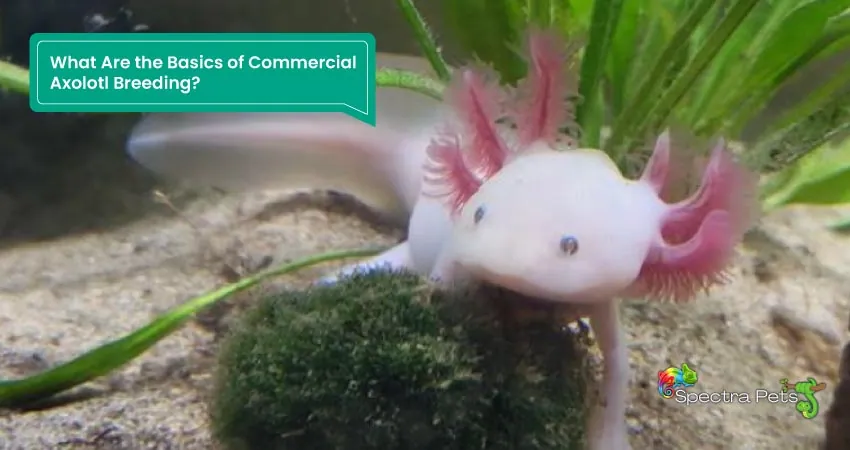
In their native habitat in Xochimilco, axolotls live underwater all their lives, a trait called ‘neoteny.’ Primarily nocturnal, they feed on a variety of foods, from small fish and worms to soft pellets. Understanding these basic habits plays a vital role in maintaining the health and breeding readiness of your axolotls.
Their inherent ability to regenerate lost limbs and organs, while fascinating from a scientific standpoint, also underlines their resilience—an essential attribute for breeding. Additionally, being cold-blooded animals, they require relatively cooler temperatures, ideally between 60-64 degrees Fahrenheit (15-18 degrees Celsius). Any deviation from these conditions may impact their health and consequently their breeding potential.
Getting a firm grasp on the life cycle and breeding needs of axolotls is crucial for anyone aspiring to enter the commercial axolotl breeding industry. Such knowledge will inform the best practices for breeding these unique amphibians, ensuring that your venture is both ethical and successful.
Axolotls’ Reproduction Cycle and Breeding Needs
Axolotls reach sexual maturity between 12 to 18 months, which marks the beginning of their reproductive phase. The female axolotls lay eggs that attach themselves to plants and other surfaces in their aquatic habitat. A single female can lay anywhere from 100 to 1,000 eggs at a time.
Notably, environmental conditions significantly influence axolotl breeding. The mating process often occurs in response to the changing seasons, particularly following a period of cooler temperatures. Therefore, the breeders must understand these environmental triggers and replicate the natural conditions as closely as possible to encourage successful mating.
Understanding the financial implications of breeding axolotls commercially is equally important. It is crucial to estimate the initial investment, operational costs, potential profitability, and return on investment to make informed decisions.
The Financial Aspect: Cost of Starting an Axolotl Breeding Business
The startup cost for an axolotl breeding business can vary widely, depending on various factors, including the scale of the operation, the location, and the type of equipment used. The main costs include acquiring breeding pairs, setting up the breeding tanks, feeding, maintenance, and potential veterinary costs.
According to a study published in the International Journal of Exotic Pet Medicine, the average setup cost for a small-scale breeding operation with two breeding pairs is around $200-$300. However, for a larger scale commercial setup, the costs can escalate to several thousand dollars. Consequently, a thorough understanding of the financial commitments involved in commercial axolotl breeding is paramount.
Now that we’ve covered the basics let’s delve into how to prepare for breeding axolotls, starting from setting up the right tank conditions, determining the correct diet, to understanding the essential equipment and supplies needed in a breeding setup.
How Can You Prepare for Breeding Axolotls?
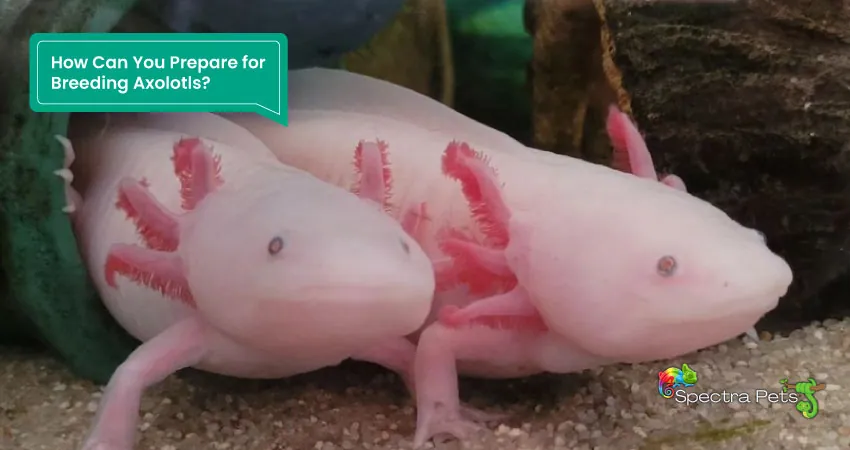
Axolotls need a very specific set of conditions in their habitat to thrive and breed successfully. The tank setup for axolotls should mimic their natural environment as closely as possible to keep them healthy and willing to reproduce.
Ideal Tank Setup
An ideal tank should have a stable temperature between 60-64 degrees Fahrenheit (15-18 degrees Celsius), and the water should be kept clean and well-filtered to prevent the accumulation of harmful bacteria. Moreover, the tank should have plenty of hiding spots and substrates that mimic the axolotl’s natural habitat.
A research study in the journal of Aquaculture highlighted the importance of tank design in successful breeding. The researchers found that axolotls bred more successfully in tanks with plenty of plants and hiding spaces, as these conditions simulated their natural environment.
Choosing the Correct Diet for Breeding Axolotls
Feeding axolotls a well-balanced diet is crucial to their health and reproductive success. Axolotls in the wild eat a varied diet, including small fish, crustaceans, and insect larvae. In captivity, they can be fed a diet of brine shrimp, bloodworms, and specially formulated axolotl pellets.
Nutrition plays a significant role in axolotl reproduction. A study published in Comparative Biochemistry and Physiology found that axolotls fed a varied diet had a higher success rate in breeding compared to those fed a monotonous diet. Therefore, it is essential to provide a diet that is diverse and rich in essential nutrients to boost breeding success.
Essential Equipment and Supplies for a Breeding Setup
Setting up a commercial axolotl breeding operation requires more than just tanks and axolotls. You’ll also need a variety of other equipment and supplies, including filters, chillers, heaters, lighting, a variety of food, and cleaning supplies. Moreover, given the axolotls’ sensitivity to water conditions, you would need test kits to monitor water quality regularly.
As part of the preparation, it’s also essential to choose the right axolotls for breeding. This includes understanding the criteria for choosing breeding axolotls, the importance of genetic diversity, and the risks and rewards of selective breeding.
How To Select Axolotls for Breeding?
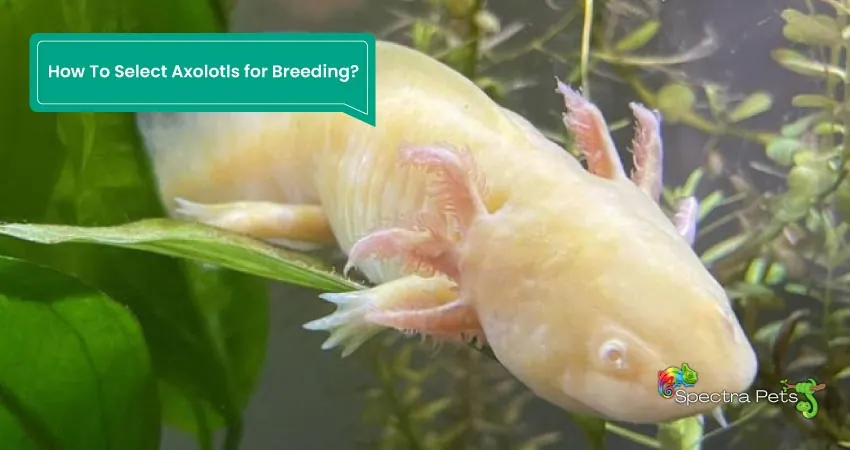
When it comes to selecting axolotls for breeding, several factors come into play. For starters, both axolotls must be healthy and free from any visible signs of disease or stress. They should also be sexually mature, which typically occurs when they reach a length of about 18 centimeters (around 7 inches) and are at least one year old. Additionally, it’s important to ensure the selected axolotls are not closely related to avoid the potential risks associated with inbreeding.
The Importance of Axolotl Genetic Diversity in Breeding
Maintaining genetic diversity is crucial for the health and survival of any species, including axolotls. Genetic diversity allows for a wider range of traits, increasing the chance of survival and adaptation in changing environments. Therefore, it is essential to select axolotls with varied genetic backgrounds for breeding.
A paper in the journal of Conservation Genetics stressed the need for genetic diversity in captive breeding programs for endangered species like the axolotl, highlighting the risks of inbreeding and genetic drift.
The Risks and Rewards of Selective Breeding in Axolotls
Selective breeding involves choosing specific axolotls to reproduce based on desired traits. This could be certain colors, patterns, or other physical characteristics. While this can lead to more attractive or unique axolotls, which might fetch higher prices, it also comes with risks. Selective breeding can lead to a reduction in genetic diversity, resulting in health issues in the offspring.
Once you have selected suitable axolotls for breeding and prepared the breeding environment, the next step is to understand the process of breeding axolotls. This includes initiating breeding, caring for the axolotl during gestation, and looking after the eggs and larvae.
Process of Breeding Axolotls
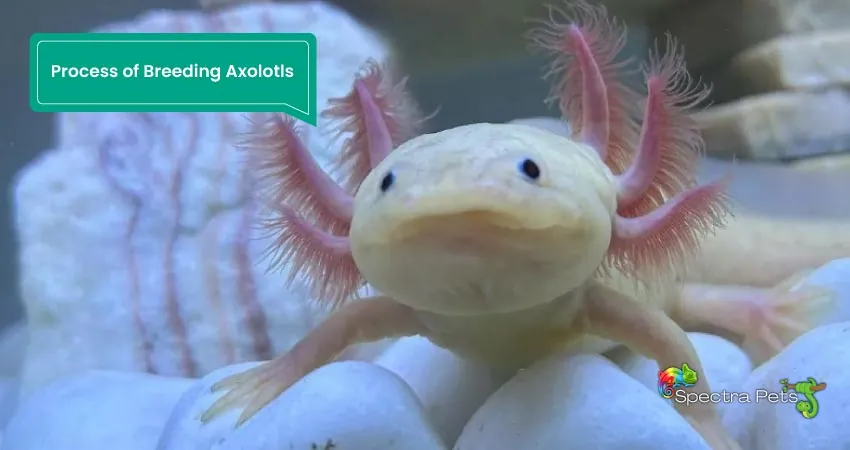
Initiating axolotl breeding involves replicating the conditions that trigger their breeding in the wild. As mentioned earlier, axolotls typically breed in response to seasonal changes. In captivity, this can be simulated by gradually lowering the water temperature in the tank to around 60 degrees Fahrenheit and then slowly raising it over several weeks. This simulates the transition from winter to spring, which is when axolotls typically breed.
The male axolotl initiates the breeding process by performing a “dance” to attract the female. He then deposits packets of sperm, known as spermatophores, which the female picks up to fertilize her eggs. After fertilization, the female will lay her eggs, which will attach themselves to various surfaces in the tank.
Guideline for Care During the Axolotl Gestation Period
Caring for a pregnant axolotl involves providing a diet rich in nutrients and maintaining optimal water conditions. It’s also important to reduce stress for the female axolotl during this time, as stress can lead to complications in the pregnancy.
Axolotl eggs usually hatch within two to three weeks, and the resulting larvae look like miniature versions of adult axolotls. At this stage, the young axolotls require a specific set of care requirements.
Caring for Axolotl Eggs and Larvae
Axolotl eggs and larvae are delicate and need careful handling. The eggs should not be disturbed and should be kept in clean, cool water. Once the larvae hatch, they should be fed live baby brine shrimp or microworms until they are large enough to eat larger food items. The larvae should also be monitored closely for any signs of disease or distress.
Breeding axolotls is not without its challenges. From health issues to regulatory hurdles and market dynamics, various factors need to be considered to ensure a successful and profitable venture.
What Are the Challenges of Axolotl Breeding?

Breeding axolotls, a unique species of aquatic salamanders, can present several challenges. Here are some of the main difficulties encountered in axolotl breeding:
1. Health Issues
Axolotls, like all living creatures, can face a range of health issues. These can range from fungal and bacterial infections to physical injuries and digestive problems. In breeding axolotls, these health issues can be compounded by stress and inadequate conditions.
Stress is a common issue in breeding axolotls, often resulting from poor water conditions, overcrowding, or inadequate diet. It can lead to a lowered immune response, making the axolotls more susceptible to infections.
Additionally, axolotls can suffer from a condition called ‘floating syndrome,’ where they struggle to swim down to the bottom of their tank. This can be caused by a range of issues, including poor diet, bacterial infection, or constipation.
Understanding these common health issues, their causes, and ways to prevent them is crucial for any successful axolotl breeding operation.
2. Regulatory Hurdles in Commercial Axolotl Breeding
Depending on your location, there may be regulatory hurdles to overcome in setting up a commercial axolotl breeding operation. For example, in some jurisdictions, you may need a permit or license to breed and sell axolotls.
Furthermore, some areas have restrictions on the sale and transport of axolotls due to their status as an endangered species. For example, in the United States, it’s illegal to transport axolotls across state lines without a permit due to their listing in the U.S. Endangered Species Act.
3. Understanding the Market Dynamics for Axolotls
Finally, understanding the market dynamics for axolotls is crucial for a profitable breeding operation. This includes understanding who your potential customers are, how much they are willing to pay for axolotls, and the factors that influence their buying decisions.
Demand for axolotls can be influenced by a range of factors, including trends in the pet industry, changes in legislation, and even media coverage of axolotls. Therefore, it’s important to keep a close eye on the market and adjust your breeding operation accordingly.
Breeding axolotls for profit can be a rewarding venture, both financially and personally. However, like any business, it requires careful planning, a deep understanding of the species, and a keen eye on the market dynamics. By following the guidelines outlined in this comprehensive guide, you can embark on your journey in the commercial axolotl breeding world.
How Can You Increase the Profitability of Axolotl Breeding?
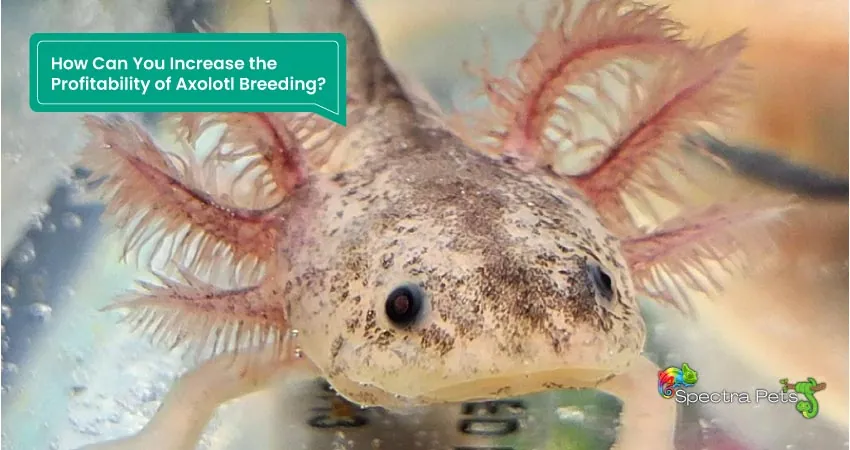
Making your axolotl breeding operation more profitable involves optimizing both the breeding process and the business model. There are several strategies that you can use to do this.
Optimize the Breeding Process
Optimizing the breeding process can help increase the number of axolotls you produce, thereby increasing potential profits. This can involve improving the conditions in your breeding tanks, providing a higher quality diet to your axolotls, or even selectively breeding axolotls to produce unique or highly sought-after color variants.
Research published in the journal Aquaculture showed that minor adjustments in the breeding tank, such as adding more plants and hiding spots, could significantly improve the breeding success rate of axolotls. Furthermore, a well-balanced diet has been found to not only improve the health of the axolotls but also increase their reproductive success.
Increase the Value of Your Axolotls
Another way to increase the profitability of your axolotl breeding operation is to increase the value of the axolotls you produce. This could be through selectively breeding for specific traits that are highly valued in the market or offering ‘add-on’ services such as tank setups or care guides.
Moreover, breeding rare axolotl color variants, such as golden albino or melanoid, can fetch a higher price in the market. However, remember the risk associated with selective breeding that we discussed earlier.
Expand Your Market
Expanding your market can also help increase profitability. This could involve selling your axolotls online or at pet expos, partnering with local pet stores, or even exporting your axolotls overseas (where it is legal and ethical to do so).
However, remember to consider the legal and ethical implications of expanding your market, especially when it involves transporting axolotls across state or national borders.
Diversify Your Income Streams
Finally, diversifying your income streams can provide additional revenue and help stabilize your income. This could involve selling axolotl-related products, such as care guides, tank setups, or axolotl food, or offering services such as axolotl care classes or tank maintenance.
What Are the Ethical Considerations in Commercial Axolotl Breeding?
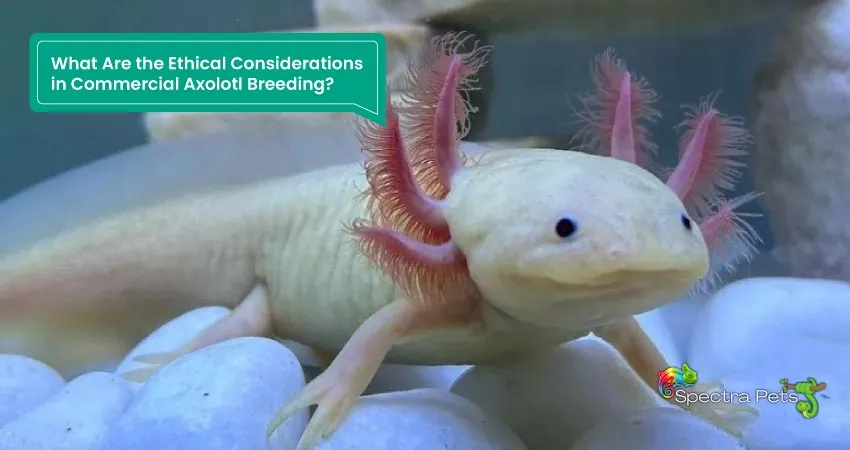
Like any business involving live animals, commercial axolotl breeding comes with a set of ethical considerations. These relate to the welfare of the axolotls in your care, your impact on wild axolotl populations, and your responsibilities to your customers.
Ensuring the Welfare of Your Axolotls
Ensuring the welfare of your axolotls should be a top priority in any commercial breeding operation. This involves providing them with a suitable habitat, a nutritious diet, and appropriate medical care. It also involves minimizing stress and handling your axolotls as little as possible.
Protecting Wild Axolotl Populations
Commercial axolotl breeding can potentially impact wild axolotl populations, especially if it involves capturing axolotls from the wild. It is therefore crucial to source your breeding axolotls ethically and to ensure that your operation does not contribute to the decline of wild axolotl populations.
Responsibility Towards Your Customers
As a commercial breeder, you also have a responsibility towards your customers. This involves providing them with healthy axolotls, accurate information about axolotl care, and after-sale support. You also have a responsibility to ensure that your customers understand the commitment involved in owning an axolotl and are equipped to provide them with the care they need.
Commercial axolotl breeding can be a profitable and rewarding venture, but it comes with significant responsibilities. By considering these ethical aspects, you can ensure that your operation contributes positively to the conservation of this unique and endangered species while also providing joy to axolotl enthusiasts worldwide.
What Kind of Business Plan Do You Need for Commercial Axolotl Breeding?
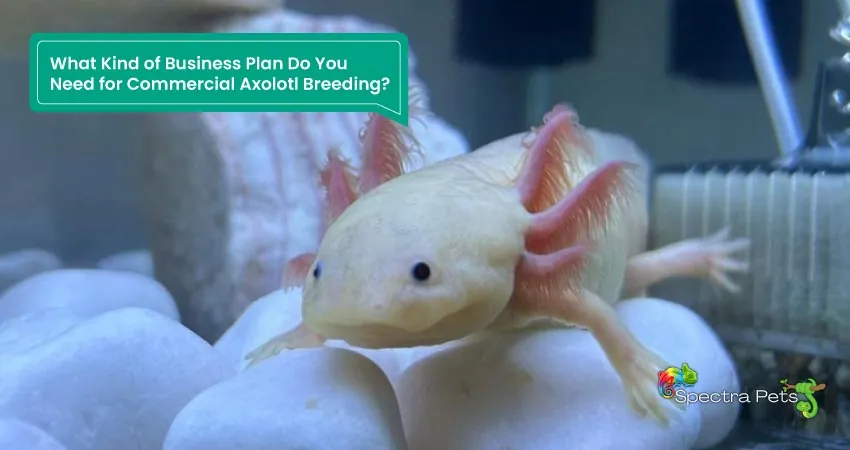
Like any business, starting a commercial axolotl breeding operation requires a solid business plan. This plan will serve as a roadmap for your business and should cover all the essential aspects of your operation, from breeding and care procedures to marketing and financial strategies.
Detailing Your Breeding Operations
The breeding operations section of your business plan should detail how you plan to breed and care for your axolotls. This should include information on your breeding tanks, feeding schedules, health care plans, and any strategies you will employ to optimize the breeding process.
Outlining Your Marketing Strategy
Your marketing strategy should detail how you plan to sell your axolotls and reach your target market. This could include selling directly to customers through an online store, partnering with local pet shops, or attending pet expos. Your marketing strategy should also cover any additional services or products you plan to offer, such as axolotl care guides or tank setups.
Financial Projections and Strategies
The financial section of your business plan should include your projected income and expenses, as well as your strategies for increasing profitability. This should consider all potential revenue streams, including the sale of axolotls, products, and services, and factor in all expenses, including initial setup costs, ongoing care costs, and marketing expenses.
Long-Term Prospects of Axolotl Breeding Business
The axolotl breeding business, like any industry, will continue to evolve in response to market trends, scientific advancements, and changes in legislation.
The Future of the Axolotl Breeding Industry: Trends and Predictions
The pet industry has seen a growing trend towards exotic and unique pets, and axolotls certainly fit the bill. As more people become aware of these fascinating creatures, demand for axolotls is expected to grow.
However, the axolotl breeding industry will need to navigate the challenge of regulation. As an endangered species, the trade of axolotls is subject to strict laws and regulations, which can vary from one jurisdiction to another.
Additionally, the rise of ethical consumerism is likely to impact the axolotl breeding industry. Consumers are increasingly looking for ethically sourced and sustainable products, and this trend extends to the pet trade.
The Role of Research and Innovation in Axolotl Breeding
Research and innovation will also play a crucial role in the future of the axolotl breeding business. Advances in breeding techniques, diet formulations, and disease prevention could all help to improve the success rate of axolotl breeding and increase profitability.
Innovation can also help breeders differentiate their business in the market, whether that’s through breeding rare color variants, providing comprehensive after-sale support, or offering innovative products and services.
Conclusion: Key Takeaways for Aspiring Axolotl Breeders
Starting a commercial axolotl breeding operation is a significant undertaking, but for those with a passion for these unique creatures, it can be a rewarding and profitable venture. Here are some key takeaways from this guide:
- Understanding axolotl care and the breeding process is paramount. This includes knowledge of their habitat, diet, health issues, and breeding behavior.
- Creating a business plan is crucial for commercial success. This should include your breeding procedures, marketing strategy, and financial projections.
- Ethical considerations should be at the forefront of your operation. This involves ensuring the welfare of your axolotls, protecting wild axolotl populations, and being responsible to your customers.
- Embrace innovation. Stay informed about the latest research in axolotl care and breeding, and look for innovative ways to differentiate your business.
- Be patient and persistent. Success may not come overnight, but with dedication and hard work, it is possible to create a profitable and sustainable axolotl breeding business.
